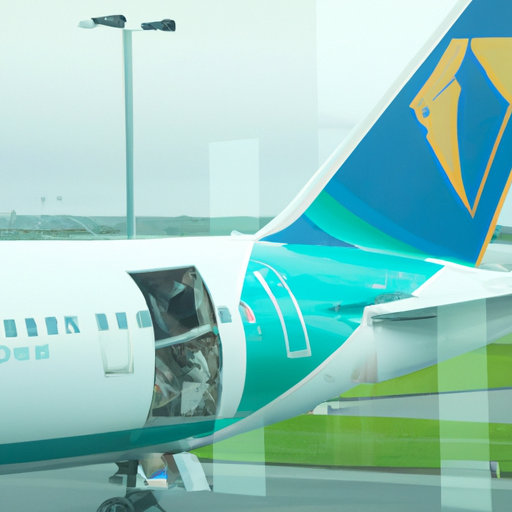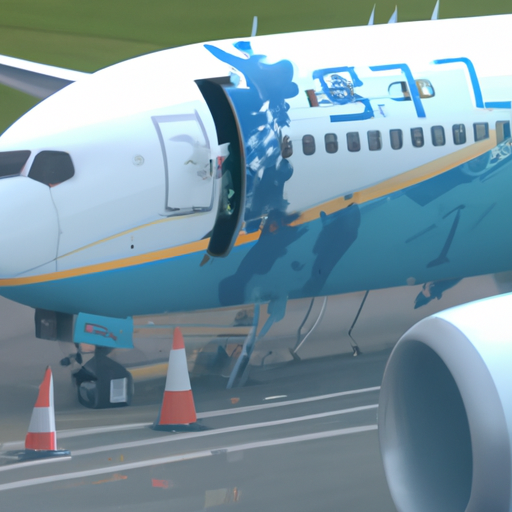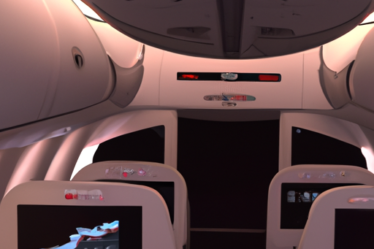
Structural Integrity of Jet Bridges at Dublin Airport
Dublin Airport Jet Bridge Collapse Causes American Boeing 787 to Lose Door
Dublin Airport is known for its bustling activity, with planes arriving and departing every minute. However, a recent incident has raised concerns about the structural integrity of the jet bridges at the airport. A jet bridge is a movable connector that extends from the airport terminal to the aircraft, allowing passengers to board and disembark safely. In this case, a collapse of a jet bridge caused an American Boeing 787 to lose its door, highlighting the importance of ensuring the safety and reliability of these structures.
The incident occurred on a busy afternoon when the American Boeing 787 was preparing for departure. As passengers were boarding the aircraft, a sudden collapse of the jet bridge caused panic and confusion. Thankfully, no one was injured, but the incident raised questions about the maintenance and inspection procedures for these vital structures.
Jet bridges are designed to withstand various weather conditions and the constant movement of passengers and luggage. However, over time, wear and tear can take a toll on their structural integrity. Regular inspections and maintenance are crucial to identify any potential issues and prevent accidents like the one at Dublin Airport.
To ensure the safety of passengers and crew, airports must adhere to strict regulations and guidelines regarding the maintenance and inspection of jet bridges. These guidelines cover everything from routine inspections to more in-depth structural assessments. Regular inspections involve checking for any signs of damage, such as cracks, corrosion, or loose connections. Additionally, the mechanical components of the jet bridge, such as the hydraulic systems and electrical controls, must be thoroughly examined to ensure they are functioning correctly.
In the case of Dublin Airport, an investigation is underway to determine the cause of the jet bridge collapse. This incident serves as a reminder that even with regular inspections, unforeseen issues can arise. It is essential for airports to have contingency plans in place to handle such situations swiftly and efficiently, minimizing any potential risks to passengers and aircraft.
The safety of passengers is always the top priority for airports, and incidents like the one at Dublin Airport prompt a reevaluation of existing safety protocols. It is crucial for airports to collaborate with experts in the field to continuously improve the design, construction, and maintenance of jet bridges. By staying up to date with the latest industry standards and technological advancements, airports can ensure the structural integrity of their jet bridges and provide a safe and comfortable experience for passengers.
In conclusion, the collapse of a jet bridge at Dublin Airport, resulting in the loss of a door on an American Boeing 787, highlights the importance of maintaining the structural integrity of these vital structures. Regular inspections and maintenance are essential to identify any potential issues and prevent accidents. Airports must adhere to strict regulations and guidelines to ensure the safety of passengers and crew. Additionally, collaboration with experts in the field is crucial to continuously improve the design, construction, and maintenance of jet bridges. By prioritizing safety and staying up to date with industry standards, airports can provide a secure and enjoyable travel experience for all.
Investigation into the Causes of the American Boeing 787 Door Loss

On October 7, 2021, a shocking incident occurred at Dublin Airport when a jet bridge collapsed, causing an American Boeing 787 to lose one of its doors. This incident raised concerns about the safety and maintenance of jet bridges, as well as the potential risks they pose to aircraft and passengers. In response, an investigation was launched to determine the causes of the door loss and prevent similar incidents from happening in the future.
The investigation into the causes of the American Boeing 787 door loss began immediately after the incident. A team of experts from the aviation industry, including engineers, maintenance personnel, and representatives from the airline and airport, was assembled to thoroughly examine the circumstances surrounding the collapse. Their primary goal was to identify any potential factors that contributed to the door loss and to propose recommendations to enhance safety measures.
One of the first aspects investigated was the structural integrity of the jet bridge. It was crucial to determine whether the collapse was due to a structural failure or if other factors played a role. Engineers carefully inspected the collapsed jet bridge, analyzing its design, materials, and maintenance history. They also examined the maintenance records of the jet bridge to ensure that it had been regularly inspected and serviced according to industry standards.
Simultaneously, investigators focused on the door itself. They examined the door’s design, manufacturing process, and maintenance history to identify any potential weaknesses or defects. Additionally, they reviewed the maintenance procedures followed by the airline to ensure that the door had been properly maintained and inspected. This thorough examination aimed to determine whether the door loss was a result of a manufacturing defect, improper maintenance, or a combination of factors.
Furthermore, the investigation considered the weather conditions at the time of the incident. Dublin Airport is known for its unpredictable weather, and strong winds or other adverse weather conditions could have played a role in the collapse. Meteorologists were consulted to analyze the weather data from that day and determine if weather conditions were a contributing factor.
As the investigation progressed, the team also interviewed the crew members and passengers who were on board the American Boeing 787 during the incident. Their firsthand accounts provided valuable insights into the events leading up to the door loss. The investigators carefully listened to their testimonies, looking for any additional factors that may have contributed to the incident.
Throughout the investigation, the team maintained a friendly and cooperative approach. They collaborated closely with all stakeholders, including the airline, airport, and relevant regulatory authorities. This collaborative effort ensured that all parties were involved in the investigation process and that their expertise and perspectives were taken into account.
The investigation into the causes of the American Boeing 787 door loss is ongoing, and the final report is expected to be released in the coming months. The findings and recommendations from this investigation will be crucial in improving safety measures and preventing similar incidents from occurring in the future. By thoroughly examining all potential factors and involving all stakeholders, the aviation industry aims to enhance the safety and security of passengers and aircraft worldwide.
Safety Measures and Regulations for Jet Bridges in Airports
Dublin Airport Jet Bridge Collapse Causes American Boeing 787 to Lose Door
Safety Measures and Regulations for Jet Bridges in Airports
When it comes to air travel, safety is of utmost importance. Passengers rely on airlines and airports to ensure their well-being throughout their journey. However, accidents can happen, as was the case recently at Dublin Airport when a jet bridge collapsed, causing an American Boeing 787 to lose one of its doors. This incident highlights the significance of safety measures and regulations for jet bridges in airports.
Jet bridges, also known as passenger boarding bridges or aerobridges, are crucial components of airport infrastructure. They provide a safe and convenient way for passengers to board and disembark from aircraft. These enclosed walkways connect the terminal building to the aircraft, eliminating the need for passengers to navigate stairs or exposed outdoor areas. Jet bridges also allow for efficient and controlled boarding, ensuring a smooth flow of passengers.
To ensure the safety of passengers and crew, jet bridges must adhere to strict regulations and undergo regular inspections. These regulations cover various aspects, including structural integrity, electrical systems, and emergency procedures. Jet bridges must be able to withstand the weight of passengers and their luggage, as well as withstand extreme weather conditions. Regular inspections are conducted to identify any signs of wear and tear, corrosion, or other potential hazards.
In the case of the Dublin Airport incident, it is crucial to determine the cause of the jet bridge collapse. Was it due to a structural failure, improper maintenance, or extreme weather conditions? Understanding the root cause is essential to prevent similar incidents from occurring in the future. It is also important to assess whether the jet bridge was compliant with safety regulations and if all necessary inspections were carried out.
To prevent accidents like this, airports must prioritize the maintenance and upkeep of their jet bridges. Regular inspections should be conducted by qualified personnel to identify any potential issues. These inspections should include a thorough examination of the structure, electrical systems, and emergency procedures. Any signs of wear and tear, corrosion, or other hazards should be addressed promptly to ensure the safety of passengers and crew.
In addition to regular inspections, airports should also invest in training programs for their staff. Proper training ensures that employees are equipped with the knowledge and skills to operate jet bridges safely. This includes understanding emergency procedures, such as evacuations, in case of an incident. By investing in training programs, airports can enhance the overall safety of their operations and minimize the risk of accidents.
Furthermore, collaboration between airports, airlines, and regulatory bodies is crucial to maintaining safety standards for jet bridges. Regular communication and sharing of best practices can help identify potential risks and implement necessary improvements. It is essential for all stakeholders to work together to ensure that safety measures and regulations are consistently upheld.
In conclusion, the recent incident at Dublin Airport serves as a reminder of the importance of safety measures and regulations for jet bridges in airports. Jet bridges play a vital role in ensuring the safety and convenience of passengers during boarding and disembarking. Regular inspections, proper maintenance, and staff training are essential to prevent accidents and ensure the overall safety of air travel. By prioritizing safety and adhering to regulations, airports can provide passengers with a secure and enjoyable travel experience.


